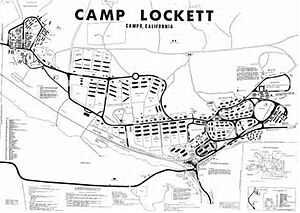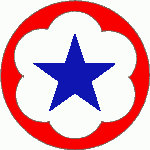Camp Lockett facts for kids
Quick facts for kids Camp Lockett |
|
|---|---|
| Part of California | |

2nd Cavalry Division's shoulder sleeve insignia
|
|
| Coordinates | 32°36′29″N 116°28′18″W / 32.608056°N 116.471667°W |
| Type | United States Army outpost |
| Site information | |
| Owner | Campo Fire and Rescue Department County of San Diego San Diego County Sheriff' Department Rancho del Campo juvenile facility Multiple private parties |
| Controlled by | San Diego County and multiple private parties |
| Open to the public |
Partially |
| Condition | Partially abandoned |
| Site history | |
| Built | 1941 |
| In use | 1876–1946 |
| Garrison information | |
| Past commanders |
COL Waldemar Falck BG Thoburn K. Brown |
| Garrison | 1st Cavalry Regiment 10th Cavalry Regiment 11th Cavalry Regiment 28th Cavalry Regiment |
| Camp Lockett | |
|---|---|
| Designated | 2009 |
| Reference no. | 1045 |
Camp Lockett was an important United States Army military base located in Campo, California. It was east of San Diego and very close to the Mexican border. This camp is famous for its connection to the Buffalo Soldiers, especially the 10th and 28th Cavalry Regiments, who were stationed there during World War II.
The camp was named after Colonel James R. Lockett. He was a brave soldier who fought in several wars, including the Spanish–American War and the Philippine Insurrection. Camp Lockett was recognized as a California Historical Landmark in 2009. There are also plans to turn a large part of its former area into a county park.
Contents
Camp Lockett: A Historic Army Post
Early Days and Conflicts
Even though people had traveled through the Campo Valley for centuries, with the Diegueño Native Americans living there first, a permanent settlement by non-Native Americans didn't appear until the late 1860s. Many settlers came from Texas, so the area was sometimes called "Little Texas." In 1869, a regular stagecoach route started, connecting San Diego to Yuma, Arizona. This route ran until 1912.
As more people moved to the American Southwest, new interactions happened between different groups. A telegraph line and a stagecoach stop were set up, bringing more business to the area. However, this also brought crime. In 1875, a serious conflict happened at Gaskill Brothers' Stone Store between local citizens and a group of bandits. This event led to the U.S. Army sending soldiers to the area for protection. A small group of ten soldiers from the 1st Cavalry Regiment became the first troops stationed in what would become Camp Lockett.
In 1876, more soldiers were sent to help when outlaws gathered nearby. Later that year, another conflict arose when a group of Native Americans came north from Mexico. The Cavalry was sent again, which led to a small group of soldiers being permanently stationed there. By 1877, the 1st Cavalry Regiment moved north for other campaigns. Other infantry regiments took their place in San Diego. In 1895, ten infantrymen were sent to Campo to prevent a group of Yaqui people, who had mutinied in Mexico, from entering the United States.
World War I and Border Patrol
During World War I, the U.S. government decided to place soldiers along the US–Mexico border. This was partly due to the Zimmermann Telegram, a secret message that suggested an alliance against the U.S. In 1918, Troop E of the 11th Cavalry Regiment was stationed at what would become Camp Lockett. The camp was named after a colonel from the 11th Cavalry Regiment.
Troop E stayed there until 1920, when they moved to Monterey, California. Another troop, Troop D, replaced them, but the force at Campo was soon reduced to just a small platoon. Eventually, all soldiers left the area when the regiment was brought back together in Monterey in the 1920s.
World War II: A Major Military Hub
Building the Camp
The first phase of construction for Camp Lockett began in 1941. It was built to house the 11th Cavalry Regiment. The camp included many buildings like barracks for soldiers, officers' quarters, dining halls, and stables for horses. There were also blacksmith shops, a veterinary facility, a hospital, administration buildings, and recreation areas.
The camp also had important infrastructure like roads, a sewage treatment plant, and a water system. Some existing buildings from before the Army arrived were also used, including the historic 1885 Gaskill Stone Store. By November 1941, Camp Lockett was ready for soldiers. It was the last military base built in California before the U.S. entered World War II.
In 1942, the 11th Cavalry Regiment moved to Fort Benning, Georgia, and became a motorized unit. The 10th Cavalry Regiment replaced them at Camp Lockett. As the war continued, new soldiers formed the 28th Cavalry Regiment, creating the 4th Cavalry Brigade of the 2nd Cavalry Division. The Western Defense Command, responsible for defending southern Arizona and California, also moved to Camp Lockett. Like many places at the time, the base had separate facilities for different groups of soldiers, and African-American soldiers faced discrimination in nearby towns.
Expanding the Camp
Because more soldiers arrived, a second phase of construction took place from 1942 to 1943. Most of these new buildings were for the 28th Cavalry Regiment, about a mile north of the original camp. This new area included more stables, hay sheds, and blacksmith shops. The veterinary hospital was also expanded.
Additional buildings included headquarters, barracks, dining halls, and storage rooms. Support buildings like a post exchange (a store for soldiers), a chapel, a motor pool, and a fire station were also added. For recreation, a swimming pool, officers' clubs, a gymnasium, and an outdoor amphitheater called Merritt Bowl were built. This expansion was so large that the nearby Campo border crossing had to be closed.
In early 1944, the 4th Cavalry Brigade was sent to North Africa. There, they were reorganized into different service units. With their departure, the era of horse soldiers at Camp Lockett came to an end. The camp then remained on standby for several months.
A Hospital and POW Camp
In July 1944, the Army Service Forces opened the Mitchell Convalescent Hospital at Camp Lockett. This was the first Army Service Forces hospital in the United States designed to help soldiers recover from injuries or illnesses. Many existing buildings were moved and changed to become hospital wards and other facilities. The hospital was named after Silas Weir Mitchell, a famous Civil War doctor.
At the same time, a prisoner of war (POW) camp was set up in the 28th Cavalry Regiment area. This camp housed Italian and German prisoners of war. These prisoners helped with various tasks at the hospital, including services, maintenance, and construction. The hospital officially closed on March 22, 1946.
Base Closure and Current Status
The convalescent hospital remained active until June 1946, when the entire facility closed. The land was then declared surplus, meaning it was no longer needed by the Army. Starting in 1949, the Army began to close the base completely. Leased properties were returned to their original owners. About 600 acres were given to the County of San Diego, and 39 acres went to the Mountain Empire Union High School District.
In 2003, the former military base was recognized as a Historic District by the State of California. In 2009, the San Diego County Probation Department announced plans to close its facilities at the former Camp Lockett site.
Buildings and Features
The historic district of Camp Lockett still includes 52 standing buildings and two complexes built during its active period. Most of these buildings were constructed by the Army using wood frames. Some older buildings from before the Army, like the Gaskill Brothers Stone Store, were also used by the military.
Many of the surviving buildings are from the first phase of construction in 1941. These include mess halls, barracks, officers' quarters, and supply buildings. Recreational buildings like the base theater, a swimming pool (now filled), and bathhouses are also still present. Buildings for the horses, such as stables and a blacksmith shop, can also be seen. Other general support buildings include a firehouse, guardhouse, and motor pool garage.
The hospital area still has administrative buildings, wards, and mess halls. Important infrastructure like the sewage plant and parts of the water system also remain.
There are also historic archaeological features, such as foundations of old barracks, day rooms, and stables. These features help us understand where buildings once stood. Landscape features like original roads, stone walls, and planted areas also contribute to the camp's history. A special feature is the Shrine built by Italian Prisoners of War, located about a mile north of the main camp. It's a small shrine built into a rock, with a statuette and engraved stone.
Camp Lockett in Media
A reunion of former cavalrymen who served at Camp Lockett was featured on the PBS TV program California's Gold.





